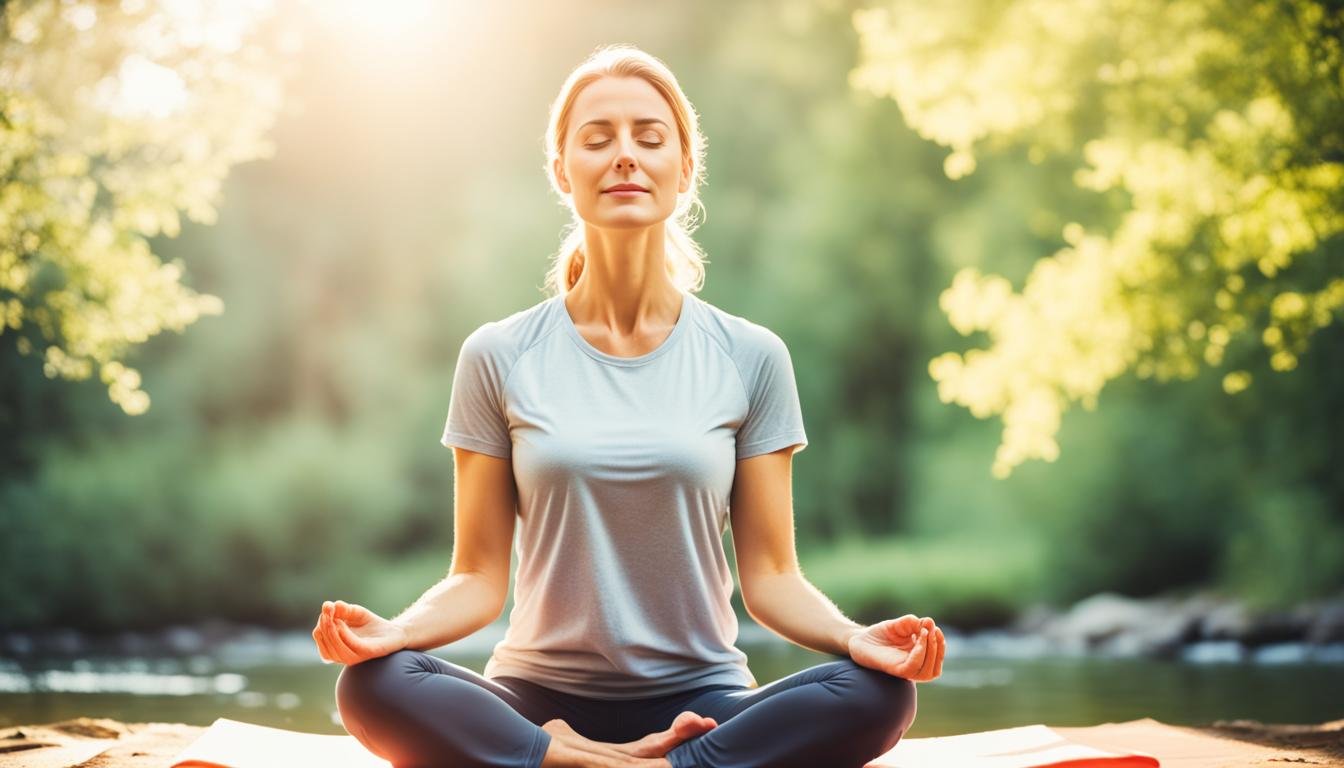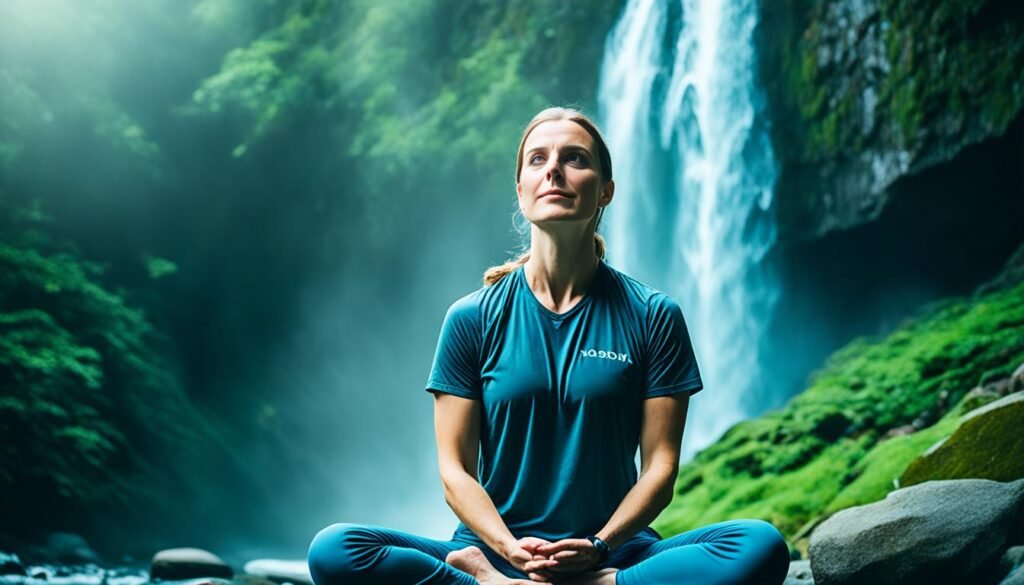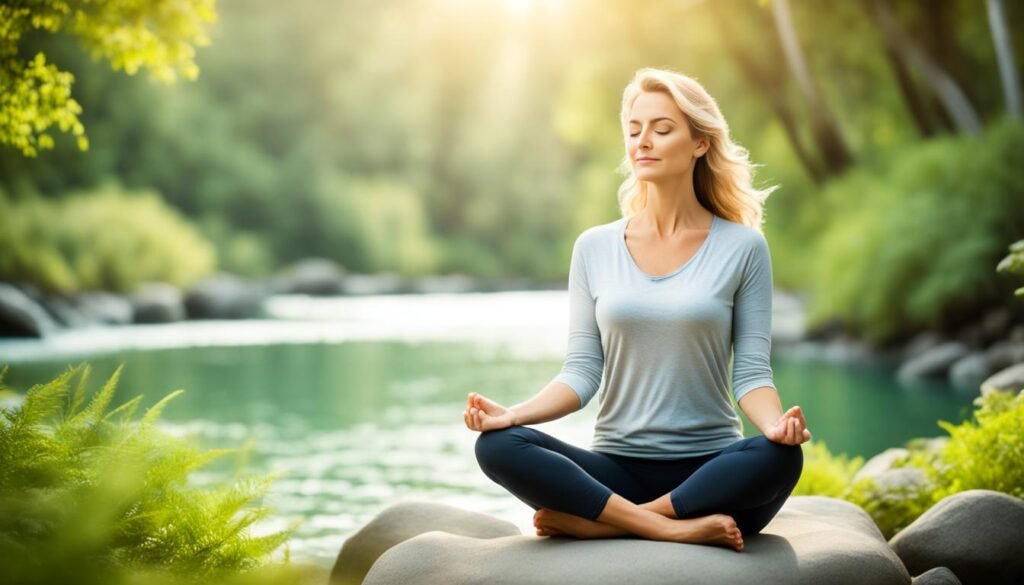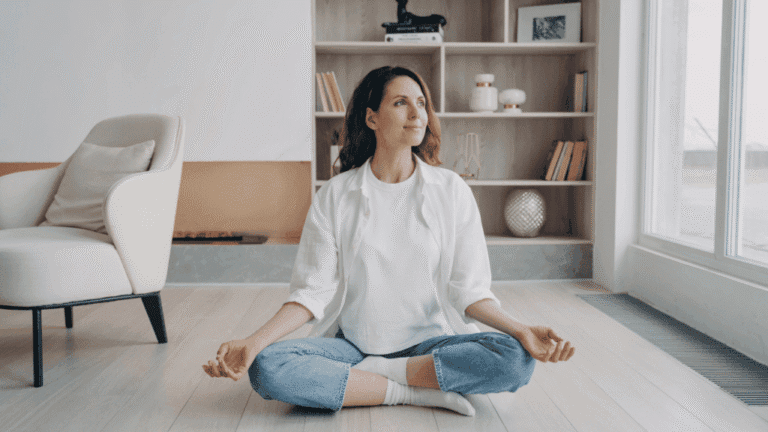How to Start Meditating Daily Beginner Techniques Explained

Are you ready to start a journey that can make you feel better and calmer? How to Start Meditating Daily could be the key. Studies show that just 12 minutes of mindfulness meditation each day can change your brain, lower anxiety, boost your immune system, and make you happier.
Starting meditation might seem hard, but small steps can make a big difference. Begin with five minutes a day and slowly add more time. It takes about 66 days to make a new habit, so be patient and celebrate your progress.
When you start meditating, be kind to yourself and keep an open mind. Welcome whatever happens in the moment, whether it’s calm or your mind wanders. Try focusing on your breath, a sound, or other techniques to find what works for you.
Key Takeaways
- Just 12 minutes of how to Start Meditating Daily can lead to noticeable improvements in well-being
- Start with short sessions and gradually increase duration over time
- Establishing a meditation habit takes approximately 66 days
- Approach each session with a non-judgmental attitude and embrace the present moment
- Experiment with different focal points and techniques to find what works best for you
Understanding the Benefits of Daily Meditation
Starting a daily meditation habit can change your life for the better. It boosts your mental, emotional, and physical health. Studies show that daily meditators feel up to 65% better overall.
Just a few minutes each day can bring many benefits. These benefits can make your life better in many ways.
Reducing Stress and Anxiety
Meditation is great for lowering stress and easing anxiety. Our lives are often filled with stress and pressure. Meditation offers a peaceful place to find calm and peace.
A 2017 review looked at 45 studies and found meditation can lower stress. A 2014 study with nearly 1,300 adults showed it can reduce anxiety, especially for those feeling very anxious.
“Meditation is a way to train the mind, just as we exercise to strengthen the body. It allows us to cultivate a sense of calm, clarity, and inner harmony, even amidst the chaos of daily life.”
Improving Focus and Concentration
Meditation also helps you focus and concentrate better. It trains your mind to be more mindful and attentive. A study found 13 minutes of daily meditation can improve attention and memory after eight weeks.
This sharper mind can lead to more productivity, better decisions, and solving problems more effectively. It helps in both work and personal life.
| Meditation Duration | Reported Benefits |
|---|---|
| 3-5 minutes | Increased relaxation and stress reduction |
| 10 minutes | Improved focus and concentration |
| 20 minutes | Enhanced emotional regulation and self-awareness |
| 30+ minutes | Deeper states of meditation and expanded consciousness |
Enhancing Emotional Well-being
Meditation is great for managing emotions and improving well-being. It makes you more aware of your thoughts and feelings. This helps you handle challenges better.
A 2015 study found meditation can reduce negative thoughts when looking at negative images. A 2019 study showed it can make you feel less lonely and increase social contact.
- Set aside a dedicated time and space for your daily meditation practice.
- Begin with short sessions of 5-10 minutes and gradually increase the duration as you become more comfortable.
- Explore different meditation techniques to find what resonates with you, such as mindfulness, loving-kindness, or guided visualizations.
- Approach your practice with patience, self-compassion, and an open mind, allowing the benefits to unfold naturally over time.
By starting daily meditation, you start a journey of self-discovery and growth. With a regular practice, you’ll see less stress, better focus, and improved emotional health. This leads to a more fulfilling and peaceful life.
How to start meditating daily Choosing the Right Meditation Technique for You
Starting your daily meditation journey means trying out different techniques to find what feels right for you. There are many options, so you can find a practice that makes you happy and helps you grow.
Mindfulness Meditation
Mindfulness meditation is a favorite in the West. It helps you focus on now. You use your breath to stay aware and accept your thoughts and feelings without judging them. This practice can make you more focused, happy, and in control.
Loving-Kindness Meditation
Loving-kindness meditation, or Metta meditation, is about growing compassion for yourself and others. You say kind words to yourself and others in your mind. This can make you feel more connected and happy.
| Meditation Type | Key Benefits |
|---|---|
| Mindfulness Meditation | Improved focus, happiness, memory, and self-control |
| Loving-Kindness Meditation | Enhanced empathy, connection, and emotional well-being |
Guided Visualization
Guided visualization uses your imagination to relax and calm you. An instructor or recording leads you through a peaceful place in your mind. This can lower stress, improve your mood, and bring peace.
“Meditation is a way of learning how to let go. It is a way of learning how to be with whatever is happening in the present moment, without resistance.” – Jon Kabat-Zinn
Trying out different meditation techniques is a personal journey. Don’t be afraid to experiment and listen to what feels right for you. Finding the right practice can lead to a journey of self-discovery and growth.
Setting Up a Comfortable Meditation Space
Creating a dedicated meditation space is key for a consistent and effective practice. Set aside a quiet, clutter-free area in your home. This will help you feel more comfortable and peaceful during meditation. Think about adding things that make you relax and feel connected.
Start by picking a peaceful spot in your home away from distractions. 90% of meditation spaces are indoors, giving you more control over your environment. If you’re short on space, don’t worry. 25% of meditation spaces use rooms or corners that aren’t used much. Making your own meditation space can be fun and rewarding.
After picking your spot, keep it clean and tidy to help your mind stay clear. Use a meditation cushion or chair for comfort and good posture. Ethel Studio’s zero waste meditation cushions are a great choice at $148.
“The space you create externally will support you internally.” – Jaymie Friesen, Mindfulness Coach
To make your space more calming, add things like:
- Soft lighting, such as salt lamps or dimmer switches
- Plants or natural elements like wood flooring
- Soothing artwork or tapestries
- Essential oils and diffusers for aromatherapy benefits
Adding personal items to your meditation space can deepen your connection to it. 80% of meditation corners have items like Buddha statues, family photos, and special items. These remind you of your goals and values. I Am & Co’s affirmation card deck is a great, affordable addition at $15.
| Design Element | Percentage of Meditation Spaces |
|---|---|
| Pastel colors and soft hues | 20% |
| Essential oils and diffusers | 40% |
| Textiles (rugs, cushions, blankets) | 30% |
| Natural elements (wood, salt lamps, plants) | 50% |
By carefully choosing your meditation space, you make a sanctuary for mindfulness and well-being. Design a space that reflects your personal style and goals. Even small touches can greatly improve your meditation practice.
Incorporating Deep Breathing Techniques
Deep breathing is key to effective meditation, helping you relax and cut stress. By adding specific breathing methods to your daily life, you can use your breath to improve your well-being. These techniques boost focus and manage emotions, making them vital for mindfulness.
Starting your meditation path, try different deep breathing methods to find what suits you best. Breath-focused meditation has many techniques, each with unique benefits for relaxation and peace.
Diaphragmatic Breathing
Diaphragmatic breathing, or belly breathing, uses the diaphragm for deeper breaths. Here’s how to do it:
- Lie down or sit comfortably with one hand on your chest and the other on your belly.
- Inhale slowly through your nose, letting your belly expand as your diaphragm contracts.
- Exhale slowly through pursed lips, feeling your belly fall as your diaphragm relaxes.
- Keep this up, focusing on how your breath moves in and out of your body.
Regular diaphragmatic breathing activates your body’s calm response. It reduces stress and brings calm and well-being.
Alternate Nostril Breathing
Alternate nostril breathing, or Nadi Shodhana, switches breath between nostrils. It’s thought to balance the brain’s left and right sides, improving focus and emotional balance. Here’s how to do it:
- Sit comfortably with your spine straight and your left hand on your lap.
- Bring your right hand to your nose, using your thumb to close your right nostril.
- Inhale slowly through your left nostril, then close it with your ring finger.
- Release your thumb and exhale through your right nostril.
- Inhale through your right nostril, then close it with your thumb.
- Release your ring finger and exhale through your left nostril.
- Keep switching nostrils with each breath.
Adding alternate nostril breathing to your meditation can bring balance and harmony in your mind and heart.
| Breathing Technique | Key Benefits |
|---|---|
| Diaphragmatic Breathing | Activates relaxation response, reduces stress |
| Alternate Nostril Breathing | Balances brain hemispheres, promotes clarity and emotional equilibrium |
Use these deep breathing methods in your daily meditation to tap into the power of your breath. This can help you relax, reduce stress, and improve your well-being. Remember, doing these regularly brings the best benefits.
Starting with Short Meditation Sessions
Starting your meditation journey with short sessions is key. These sessions help you build a strong foundation for a lasting practice. They make it easier to get used to meditation without feeling overwhelmed.
Beginning with 5-10 Minute Sessions
For beginners, 5-10 minutes a day is a great start. Studies show that how often you meditate is more important than how long. Daily practice is better than long sessions now and then.
Even a short guided meditation can help. Apps like Headspace offer these sessions. They can reduce stress and improve focus.
Here are some interesting facts:
- A 2018 study found that 10 days of Headspace meditation cut stress by 11%. After 30 days, stress went down by 32%.
- Short sessions of 1 to 5 minutes a day can help you make meditation a habit. You can do them anytime, anywhere.
- Just 10 days of Headspace can lower stress by 12%. One session can reduce mind-wandering by 15%.
Gradually Increasing Duration
As you get more comfortable with meditation, you can make your sessions longer. This lets you explore deeper into meditation without feeling rushed. Remember, it’s important to meditate regularly to see the best results.
| Meditation Duration | Benefits |
|---|---|
| 5-10 minutes | Stress reduction, improved focus, habit formation |
| 10-20 minutes | Enhanced emotional regulation, increased mindfulness |
| 20-30 minutes | Deeper relaxation, improved problem-solving, greater resilience |
Daily meditation can lead to better sleep, less stress, more resilience, kinder behavior, and overall happiness and health.
As you move forward, focus on the quality of your meditation, not just the time. Be patient, kind to yourself, and curious. This will help you build a powerful and lasting meditation habit.
How to Start Meditating Daily
Starting a daily meditation routine is key to enjoying its many benefits. Studies show that meditating every day is crucial for seeing results. By making meditation a must-do part of your day, you’ll start feeling more peaceful and well.
Choosing a Consistent Time
Finding the right time to meditate is crucial. Research suggests that morning meditation helps people stick with it. But pick a time that fits your life, whether it’s early morning, lunch, or before bed.
Start with short sessions, like 5 minutes, three times a week. As you get into it, you can slowly increase the time. Aim for 10 to 15 minutes daily for the best effects.
Making Meditation a Priority
To make meditation a part of your day, treat it like you would any other important activity. Studies show that linking meditation with daily habits can help you keep it up.
“Meditation is not about stopping thoughts, but rather about becoming more aware of them.” – Headspace
Being flexible with your meditation schedule helps you keep it up. Even a quick 3 to 5-minute session is good. Use guided meditations, calming sounds, or breathing exercises to help your practice.
Tracking Progress and Celebrating Milestones
Keeping an eye on your progress keeps you motivated. Use a journal or apps like Calm, Headspace, or Ten Percent Happier to track your meditation. Writing down why you missed a session can help you see why it’s important to keep going.
| Milestone | Celebration Idea |
|---|---|
| 7 consecutive days of meditation | Treat yourself to a relaxing bath or massage |
| 30 consecutive days of meditation | Invest in a high-quality meditation cushion or mat |
| 100 consecutive days of meditation | Attend a meditation retreat or workshop |
Celebrating your achievements makes your practice more meaningful. Acknowledge the good things you notice after each session. Reward yourself for big milestones, like meditating every day or feeling better overall.
Building a daily meditation habit takes time, patience, and consistency. By prioritizing meditation, tracking your progress, and celebrating your wins, you’ll make meditation a key part of your life.
Overcoming Common Meditation Challenges
Starting your daily meditation journey, you’ll find even seasoned meditators face hurdles. It’s crucial to tackle these challenges with patience and kindness towards yourself. By facing issues like a wandering mind and physical discomfort, you can make your meditation more meaningful and strong.
Dealing with a Wandering Mind
A common challenge in meditation is a wandering mind, affecting 75% of those who practice. Thoughts pop up during meditation, and it’s key to not judge them. Instead, just notice them and gently bring your focus back to your chosen meditation topic, like your breath. The aim is to be aware and accepting, not to stop thinking completely.
Studies show that mindfulness meditation boosts focus and concentration, especially for those with ADHD. A review of 47 studies found it helps with focus and cuts impulsivity. With practice, 90% of meditators see big improvements in staying focused.
Managing Restlessness and Discomfort
About 25% of people feel physical discomfort or restlessness during meditation. This can include cramps, tingling, or feeling restless. Try different sitting positions and cushions to find what’s most comfortable for you. Make sure you sit correctly, dress for the weather, and take breaks if needed.
If you’re still feeling restless, try adding some movement to your meditation. Simple stretches or walking meditation can help. The goal is to accept these feelings and grow stronger, not to get rid of them completely.
| Meditation Challenge | Percentage of Meditators Affected |
|---|---|
| Mind Wandering | 75% |
| Self-Criticism | 60% |
| Restlessness | 25% |
| Sleepiness | 20% |
| Doubt | 30% |
Remember, each challenge in meditation is a chance to grow and learn more about yourself. With curiosity, patience, and kindness, you can turn these obstacles into steps towards better mindfulness and well-being.
Exploring Guided Meditation Resources
Starting your meditation journey? Guided meditations are a great choice for both beginners and experts. These sessions, led by skilled teachers, offer support and variety. You’ll find a guided meditation that fits your goals and likes.
Meditation apps are a great way to start. Apps like Headspace, Calm, and Insight Timer have many guided sessions for all levels. Studies show that using Headspace for 30 days can cut stress by a third. This shows how regular practice with these apps can help.
“Meditation is a way of befriending ourselves and our experiences.” – Jon Kabat-Zinn
There are also many online resources for guided meditations. You can find free instructional videos and audio on YouTube and podcasts. This lets you try different techniques and find teachers you like. Whether you like body scans, loving-kindness meditations, or mantra-based practices, there’s a guided meditation for you.
Joining a meditation community or going to workshops and retreats can also help. These in-person events let you meet others who meditate and learn more from experienced teachers. Some like the community and personal guidance they get in classes, while others prefer online resources.
| Meditation App | Key Features |
|---|---|
| Headspace | Themed courses, progress tracking, offline access |
| Calm | Sleep stories, nature sounds, daily meditations |
| Insight Timer | Large library, community features, timer function |
Trying different guided meditation resources is key to finding what works for you. Experiment with apps, online platforms, and local classes. Mixing up your resources keeps your meditation fresh, interesting, and suited to your needs.
- Choose a meditation app or online platform to explore.
- Set aside dedicated time each day for your guided meditation practice.
- Experiment with different techniques and teachers to find what resonates with you.
- Consider joining a local meditation community or attending workshops for additional support.
Remember, there’s no right or wrong way to meditate. It’s normal to face challenges at first. With regular practice and the help of guided meditations, you’ll see how powerful this practice can be in your life.
Integrating Mindfulness into Daily Life
Adding mindfulness to your daily life can make a big difference. It helps you stay present and enjoy life more. By paying attention to simple things like eating, walking, and talking, you can lower stress and improve your relationships.
Mindful Eating
Mindful eating means eating with full focus. Notice the food’s colors, smells, and tastes. This helps you enjoy your food more and eat better. It can also stop you from eating too much or eating too much sugar.
To eat mindfully:
- Focus on each bite, chew slowly, and enjoy the taste
- Listen to your body’s hunger signals, not outside pressures
- Don’t eat with your phone or while doing other things
Mindful Walking
Mindful walking turns walking into a way to meditate. Pay attention to your steps and the world around you. It can make you feel calm, alert, and alive.
To walk mindfully:
- Have a reason for your walk
- Feel your feet touch the ground and breathe deeply
- Look around with curiosity
- Bring your focus back to now if your mind drifts
Mindful Communication
Being mindful in conversations means being fully there. Listen well and respond thoughtfully. This can make your relationships stronger and deeper.
To communicate mindfully:
- Focus on the person talking, without distractions
- Listen with an open heart and mind
- Think before you speak, with kindness in mind
The American Psychological Association defines mindfulness as a sense of awareness of one’s surroundings, as well as one’s internal state of being.
Adding mindfulness to your day can bring many benefits. It can lower stress, improve your mental health, and make you happier. A 2021 study found that mindful meditation helped people feel less stressed during lockdown.
| Mindfulness Practice | Benefits |
|---|---|
| Mindful Eating | Better digestion, portion control, appreciation for nourishment |
| Mindful Walking | Calms nervous system, increases alertness, provides sense of aliveness |
| Mindful Communication | Deeper connections, enhanced understanding, compassionate responses |
By making mindfulness part of your life, you can stop the cycle of stress and negative thoughts. Instead, you can live a more peaceful and fulfilling life.
Conclusion
How to Start Meditating Daily, Starting a daily meditation journey is a great way to become more mindful, reduce stress, and improve your well-being. Meditation can lower stress hormones, make you feel more emotionally stable, boost your brain skills, and help you understand yourself better. By picking the right technique and creating a cozy space, you can start your meditation path. As you keep practicing, you might face challenges like a busy mind or feeling restless. Be patient, kind to yourself, and open to learning from these moments. They teach you important lessons about growing personally. Using guided resources and joining a supportive group can keep you on track and deepen your meditation knowledge. Bringing mindfulness into everyday activities like eating, walking, and talking can spread the benefits of meditation into your daily life.
With regular effort and commitment, meditation can become a key part of a peaceful and meaningful life. As you grow in mindfulness and self-awareness, you’ll see better health, stronger relationships, and easier handling of life’s ups and downs. Remember, every meditation session, even a short one, moves you forward on your path to personal growth and mindful living. So, dive into the journey, trust the process, and look forward to the rewards of daily meditation.
















